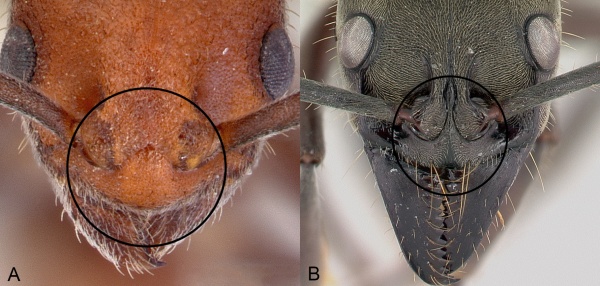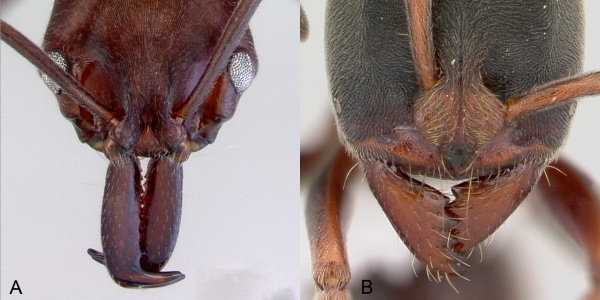Key to New World Genera of Ponerinae
This worker key is based on: Schmidt, C.A. & Shattuck, S.O. 2014. The higher classification of the ant subfamily Ponerinae (Hymenoptera: Formicidae), with a review of ponerine ecology and behavior. Zootaxa. 3817, 1–242 (doi:10.11646/zootaxa.3817.1.1)
Including all of North, Central and South America and the islands of the Caribbean.
1
- Clypeus broadly inserted between frontal lobes, which appear flattened in frontal view (Fig. A). Antennal sockets widely separated . . . . . 2
- Clypeus usually narrowly inserted between frontal lobes (Fig. B). Antennal sockets usually closely approximated . . . . . 3
2
return to couplet #1
- Mandibles subtriangular, with numerous short teeth (Fig. A) . . . . . Platythyrea
- Mandibles with three long and attenuated teeth (Fig. B) . . . . . Thaumatomyrmex
3
return to couplet #1
- Metapleural gland orifice with a posterior, inverted U-shaped cuticular lip (opening lateral and anterior of posterior propodeal face) (Fig. A) . . . . . 4
- Metapleural gland orifice without a posterior U-shaped cuticular lip (opening separated from posterior propodeal face by a very narrow, low flange) (Fig. B) . . . . . 9
4
return to couplet #3
- Propodeal spiracle slit-shaped (Fig. A) . . . . . 5
- Propodeal spiracle round or ovoid (Fig. B) . . . . . 7
5
return to couplet #4
- Massive ants (head width greater than 4.0 mm). Anterior clypeal margin with a pair of large projecting teeth (Fig. A) . . . . . Dinoponera
- Smaller ants (head width less than 4.0 mm). Anterior clypeal margin without a pair of large projecting teeth (Fig. B) . . . . . 6
6
return to couplet #5
- Hypopygium with a row of stout setae along each side of the sting (sometimes partially hidden by surrounding thinner hairs) (Fig. A). Stridulatory organ absent from A4 pretergite. Arolia not prominent and white. Preocular carinae absent . . . . . Pachycondyla
- Hypopygium without a row of stout setae along each side of the sting. Stridulatory organ present on A4 pretergite (Fig. B). Arolia prominent, projecting and usually bright white. Preocular carinae present or absent . . . . . Neoponera (in part)
7
return to couplet #4
- Ventral apex of the metatibia with a single spur, which is pectinate (Fig. A) . . . . . Simopelta
- Ventral apex of the metatibia with a large pectinate spur and a smaller simple spur (Fig. B) . . . . . 8
8
return to couplet #7
- Metanotal groove strongly developed and angular, the propodeum well below the mesonotum (Fig. A) . . . . . Mayaponera
- Metanotal groove essentially absent to weakly developed, the propodeum level with the mesonotum (Fig. B) . . . . . Neoponera (in part)
9
return to couplet #3
- Mandibles long and straight, inserted medially on the front of the head. Head with prominent ocular prominences (Fig. A) . . . . . 10
- Mandibles inserted toward the sides of the front of the head. Head without prominent ocular prominences (Fig. B) . . . . . 11
10
return to couplet #9
- Nuchal carina continuously curved, the posterior surface of the head lacking a pair of dark apophyseal lines (Fig. A) . . . . . Anochetus
- Nuchal carina medially V-shaped, the posterior surface of the head with a pair of dark converging apophyseal lines (Fig. B) . . . . . Odontomachus
11
return to couplet #9
- Mesotibiae dorsally with abundant stout traction setae (Fig. A) . . . . . 12
- Mesotibiae dorsally without abundant stout traction setae (a few stout setae sometimes present near tarsus but never extending along length of tibia) (Fig. B) . . . . . 13
12
return to couplet #11
- Eyes absent in workers, but present in queens. Metapleural gland orifice opening laterally. Head and body without a dense pubescence. Mandible with a basal groove (Fig. A) . . . . . Centromyrmex
- Eyes usually present in both workers and queens (rarely absent in workers). Metapleural gland orifice opening posteriorly at the posteroventral corner of the metapleuron. Head and body covered by a dense pubescence. Mandible without a basal groove but often with a basal pit (Fig. B) . . . . . Cryptopone
13
return to couplet #11
- Ventral apex of the metatibia with both a large pectinate spur and a smaller simple spur (Fig. A) . . . . . 14
- Ventral apex of the metatibia with a single spur, which is pectinate (Fig. B) . . . . . 17
14
return to couplet #13
- Tarsal claws usually pectinate, rarely armed with one to three preapical teeth (Fig. A) . . . . . Leptogenys
- Tarsal claws unarmed (Fig. B) . . . . . 15
15
return to couplet #14
- Mesosomal profile discontinuous, the propodeum lower than the mesonotum. Mandible with a basal pit or groove. Propodeal spiracle round. Prora absent from anterior margin of first gastral sternite (Fig. A) (Introduced in SE USA) . . . . . Brachyponera
- Mesosomal profile nearly continuous, the metanotal groove shallow or absent. Either mandible without a basal pit or groove and propodeal spiracle round or ovoid, or mandible with a basal pit or groove and propodeal spiracle slit-shaped. Prora present on anterior margin of first gastral sternite (Fig. B) . . . . . 16
16
return to couplet #15
- Mandible with a basal groove (occasionally weakly developed). Propodeal spiracle slit-shaped (Fig. A) . . . . . Pseudoponera
- Mandible without a basal groove (but a ridge sometimes present). Propodeal spiracle round or ovoid (Fig. B) . . . . . Rasopone
17
return to couplet #13
- Mandibles narrow, with several long attenuated teeth (Fig. A) . . . . . Belonopelta
- Mandibles triangular and without long attenuated teeth (Fig. B) . . . . . 18
18
return to couplet #17
- Subpetiolar process with an anterior fenestra and paired posteroventral teeth (Fig. A) . . . . . Ponera
- Subpetiolar process without both an anterior fenestra and paired posteroventral teeth . . . . . Hypoponera

















